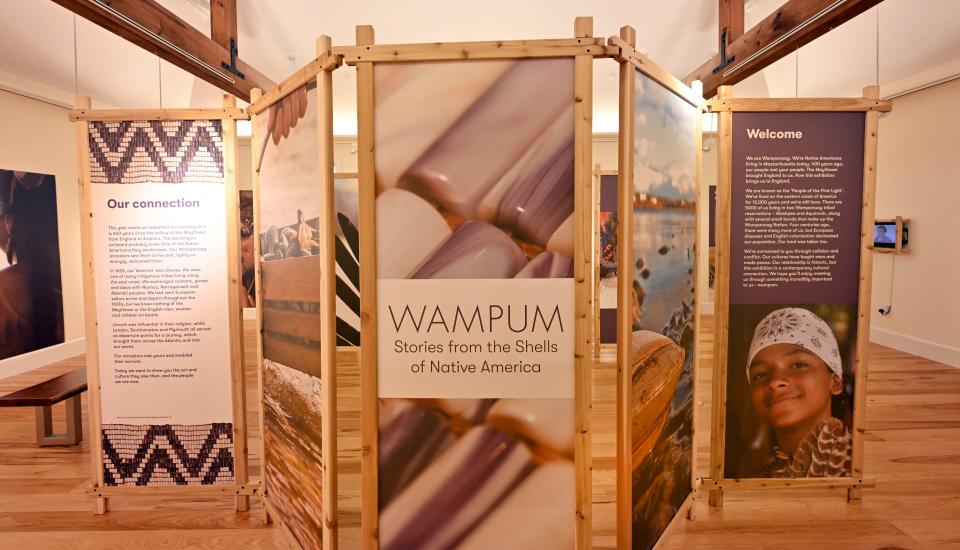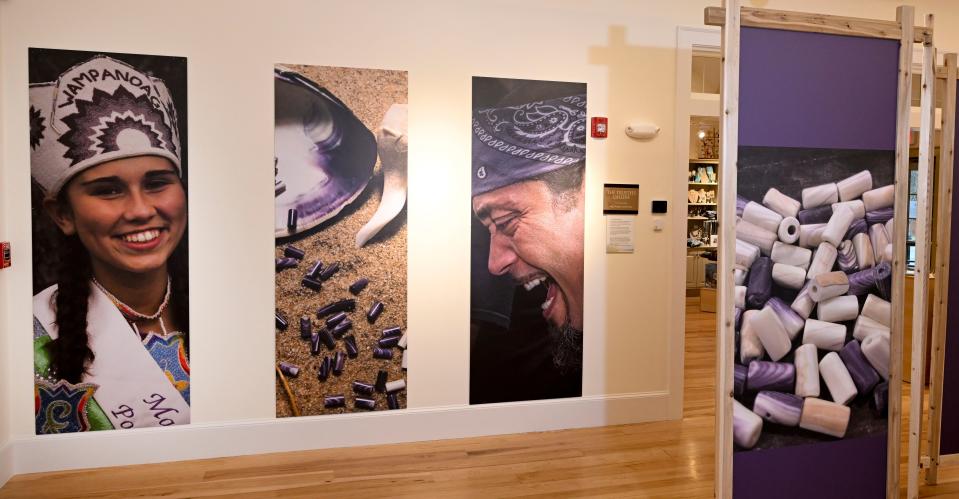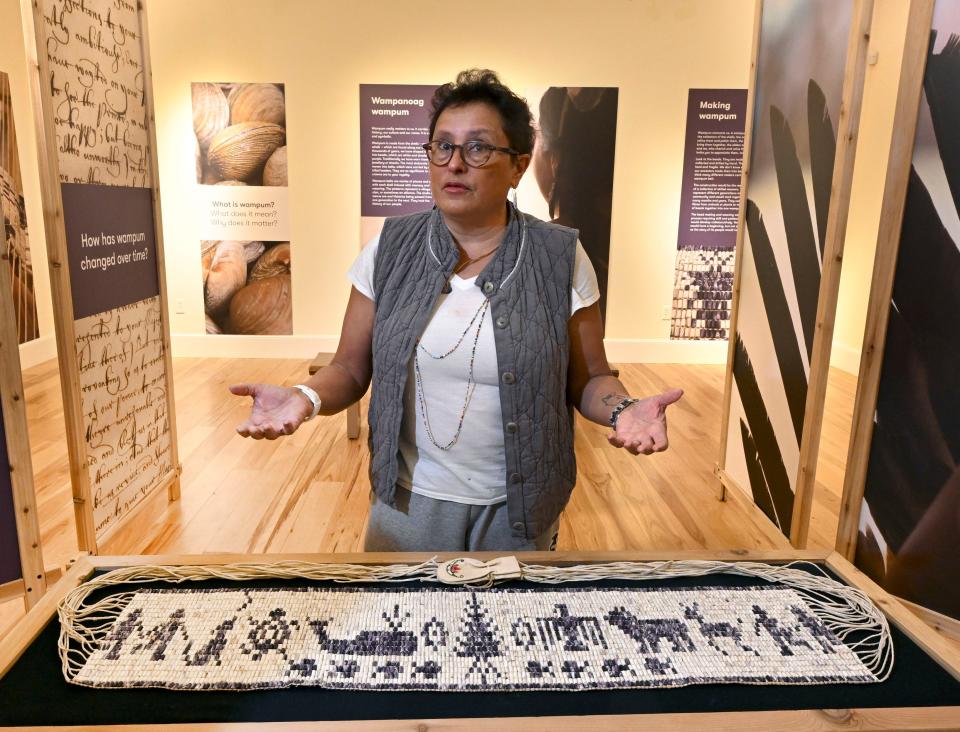King Philip's regal wampum belt was lost. See this new homage to the beaded masterpiece.
- Oops!Something went wrong.Please try again later.
In the 1600s, when the Wampanoag people on Cape Cod held ceremonial events, their leader, Metacom (aka King Philip), would have been a prominent stand-out, wearing an intricately fashioned wampum belt – woven patterns of polished beads shaped from the purple and white shells of quahog and whelk.
Historical accounts suggest that the garment hung down several feet from his shoulders, interwoven with designs that represented the histories, deeds and traditions of these indigenous people.
After Metacom was killed by the European colonists during King Philip’s War (1675-76), the regal belt, part of the spoils of victory intended for England’s king, went missing en route to its destination. A search for the famed artifact has continued to this day.

It’s now gaining attention as the result of an exhibit, “Wampum: Stories from the Shells of Native America,” that’s on display at the Cahoon Museum of American Art in Cotuit, through April 16.
At the center of the exhibit is a new wampum belt, created by members of the local Mashpee, Herring Pond, Assonet, Gay Head (Aquinnah) and Namasket Wampanoag tribes, with design input from tribal artists and educators. The idea for its creation was developed by local Cape Cod communications consulting firm SmokeSygnals and its principal, Paula Peters (Mashpee Wampanoag), an educator, former journalist and active tribal member.
Restoring an indigenous tradition
In the 2010s, Peters traveled to the U.K. to implement a tour of the “Wampum: Stories” exhibit, as part of the planned commemoration of the 400th anniversary of the Mayflower’s 1620 landing in North America. The display traveled the U.K. in 2022, part of a collaborative funding effort with the Plymouth (England) City Council and Arts Council of England, as part of the anniversary programming.

Now traveling here in the U.S. as a solo exhibit, the wampum story has become part of a growing effort to renew the art and tradition of wampum-making among the Wampanoag people. The project adds a crucial perspective to America’s ongoing story: that of the indigenous groups in North America who lived here for thousands of years before the Europeans’ arrival.
Artist and weaver Linda Coombs (Aquinnah Wampanoag), who worked with Peters on designing the belt, emphasizes the continuity. The Wampanoag people “haven’t disappeared ... We are still here, (as) a functioning indigenous tribal nation.”
More than 100 people contributed to the project, in a community effort to rediscover and relearn the intricate process by which wampum beads were created hundreds of years ago, without modern tools or instruction books. Each shell bead is hand-ground and fashioned into a tubular shape, then vertically perforated before being strung into a complex pattern, using deer hide and other sinews to connect the beads.
More than 4,300 individual beads were woven into the pattern of this belt, which measures 42 inches long and 9 inches wide, and took nearly a year to complete.
Recording history through art and memory
According to tribal creation stories, the Wampanoag people are descended from the roots of the white pine, which stands at the belt’s center. On either side are “common pot” symbols celebrating gifts of the earth, as well as clan totems such as whale, turtle and eagle. At each end of the belt, dancers move toward the pine tree at the center.

With no written language among the indigenous tribes in that early time, wampum belts were important ways of signifying events and history throughout the Wampanoags’ world, as well as a highly valued means of communication. Continuing the Wampanoag story by means of the new belt, says Peters, “helps recover part of the story” that was lost after the tribe’s history and traditions were banned by the English from being passed on, in the wake of King Philip’s War. Reviving wampum’s symbolic traditions will “bring the story forward in a way that’s authentic.”
At the end of the belt, the horizontal sinews are left long and empty of beads. The museum’s wall text reads: “a belt would have a beginning, but not a clear ending, as the story of its people would continue.” This community belt is designed as an unfinished story, with its empty strands ready for new narratives. Peters says the collective input has been “heartwarming.” And, she says, “The belt will remember the hands that touched it.”
How to see, learn about, wampum:
“Wampum: Stories from the Shells of Native America”: Through April 16 at Cahoon Museum of American Art, 4676 Falmouth Road (Route 28), Cotuit. Museum hours are 10 a.m. to 4 p.m. Wednesday through Sunday. More information: 508-428-7581 or at www.cahoonmuseum.org/
Related programs:

March 30: “The Endurance of Wampum,” a free, virtual talk with Paula Peters, 4:30 to 6 p.m. Visit www.cahoonmuseum.org to register.
April 8: Opening reception for “Wampum” exhibit, 1 to 3 p.m. in the gallery. Free with museum admission.
April 16: In-person Wampum Making Workshop with Darius Coombs (Mashpee Wampanoag), cultural outreach coordinator, Mashpee Wampanoag Education Department, 1 - 3 p.m., $25, $20 members.
Also in the galleries: "Fire and Ink: Pottery by Hollis Engley and Prints by Alice Nicholson Galick" (through June 4) and "Familiar Faces and Places in the Art of Ralph Cahoon" (year-round).
This article originally appeared on Cape Cod Times: Wampanoag history told through King Philip's recreated wampum belt

